Studies of the Solid Particle Erosion Resistance of 30 L Steel with Different Types of Surface Modification
Abstract
:1. Introduction
2. Materials and Methods
- -
- Preparation of the specimen surfaces (polishing, removal of contaminants from the surface, and degreasing);
- -
- Loading of the specimens into the vacuum chamber;
- -
- Evacuation of the vacuum chamber to a vacuum level of no more than 8–10−3 with preliminary heating of the samples to a temperature of 150 °C;
- -
- Ionic surface cleaning at a vacuum chamber pressure not more than 0.35 Pa and a temperature of specimens not more than 350 °C;
- -
- Modification of the specimen surface in a nitrogen environment for 2.5, 5, and 10 h at a vacuum chamber pressure of not more than 2.1 Pa and a specimen temperature of not more than 380 °C.
- -
- Heating and soaking the specimens at 350 °C for 2 h;
- -
- Boriding bath treatment at 880 °C for 3 h (boriding type I) and 6 h (boriding type II);
- -
- Quenching specimens in oil heated to 90 °C.
3. Results and Discussion
- -
- All studied types of surface boriding at flow impact angles of 30° and 90° worsen the solid particle erosion resistance;
- -
- All studied variants of surface nitriding at a flow impact angle of 90° do not worsen the solid particle erosion resistance of 30 L steel specimens;
- -
- All studied types of nitriding at a flow impact angle of 30° increase the solid particle erosion resistance by at least 10–20%.
4. Conclusions
Author Contributions
Funding
Institutional Review Board Statement
Informed Consent Statement
Data Availability Statement
Conflicts of Interest
References
- Zhang, Y.; Qian, Z.; Ji, B.; Wu, Y. A review of microscopic interactions between cavitation bubbles and particles in silt-laden flow. Renew. Sustain. Energy Rev. 2016, 56, 303–318. [Google Scholar] [CrossRef]
- Yi, J.Z.; Hu, H.X.; Wang, Z.B.; Zheng, Y.G. On the critical flow velocity for erosion-corrosion in local eroded regions under liquid-solid jet impingement. Wear 2019, 422–423, 94–99. [Google Scholar] [CrossRef]
- Bregliozzi, G.; Di Schino, A.; Ahmed, S.I.-U.; Kenny, J.M.; Haefke, H. Cavitation wear behaviour of austenitic stainless steels with different grain sizes. Wear 2005, 258, 503–510. [Google Scholar] [CrossRef]
- Ghiban, B.; Safta, C.-A.; Ion, M.; Crângașu, C.E.; Grecu, M.-C. Structural Aspects of Silt Erosion Resistant Materials Used in Hydraulic Machines Manufacturing. Energy Proc. 2017, 112, 75–82. [Google Scholar] [CrossRef]
- Wang, L.; Wang, H.; Wang, D. The Applied Research of Hydroturbine Prime mover and Governor Modeling of in the Yunnan Power Grid. Proc. Eng. 2011, 23, 765–768. [Google Scholar] [CrossRef]
- Kang, Z.; Feng, C.; Liu, Z.; Cang, Y.; Gao, S. Analysis of the incipient cavitation noise signal characteristics of hydro-turbine. Appl. Acoust. 2017, 127, 118–125. [Google Scholar] [CrossRef]
- Babu, A.; Perumal, G.; Arora, H.S.; Grewal, H.S. Enhanced slurry and cavitation erosion resistance of deep cryogenically treated thermal spray coatings for hydroturbine applications. Renew. Energy 2021, 180, 1044–1055. [Google Scholar] [CrossRef]
- Hamilton, A.; Sharma, A.; Pandel, U. Effect of impingement velocity on solid particle erosion behaviour of CA6NM hydroturbine steel. Mater. Today Proc. 2018, 5 Pt 1, 17325–17332. [Google Scholar] [CrossRef]
- Sharma, S.; Gandhi, B.K. Assessment of erosion wear in low specific speed Francis turbine due to particulate flow. Adv. Powder Technol. 2023, 34, 104065. [Google Scholar] [CrossRef]
- Zhang, Y.; Liu, K.; Xian, H.; Du, X. A review of methods for vortex identification in hydroturbines. Renew. Sustain. Energy Rev. 2018, 81, 1269–1285. [Google Scholar] [CrossRef]
- Krella, A.K. Degradation and Protection of Materials from Cavitation Erosion: A Review. Materials 2023, 16, 2058. [Google Scholar] [CrossRef] [PubMed]
- Liu, X.; Luo, Y.; Karney, B.W.; Wang, W. A selected literature review of efficiency improvements in hydraulic turbines. Renew. Sustain. Energy Rev. 2015, 51, 18–28. [Google Scholar] [CrossRef]
- Natsume, M.; Hayashi, Y.; Akebono, H.; Kato, M.; Sugeta, A. Fatigue properties and crack propagation behavior of stainless cast steel for turbine runner of hydraulic power generation. Proc. Eng. 2010, 2, 1273–1281. [Google Scholar] [CrossRef]
- Gabaidulin, D.Y.; Grechneva, M.V. Resources to repaire hydroturbine blades affected by cavitation. Vestnik IrGTU 2012, 12, 40–43. [Google Scholar]
- Georgievskaia, E. Justification of the hydraulic turbines lifetime from the standpoint of the fracture mechanics. Procedia Struct. Integr. 2018, 13, 971–975. [Google Scholar] [CrossRef]
- Gohil, P.P.; Saini, R.P. Investigation into cavitation damage potentiality using pressure pulsation phenomena in a low head Francis turbine for small hydropower schemes. Ocean Eng. 2022, 263, 112230. [Google Scholar] [CrossRef]
- Yu, A.; Zou, Z.; Zhou, D.; Zheng, Y.; Luo, X. Investigation of the correlation mechanism between cavitation rope behavior and pressure fluctuations in a hydraulic turbine. Renew. Energy 2020, 147, 1199–1208. [Google Scholar] [CrossRef]
- Haiko, O.; Kaikkonen, P.; Somani, M.; Valtonen, K.; Kömi, J. Characteristics of carbide-free medium-carbon bainitic steels in high-stress abrasive wear conditions. Wear 2020, 456–457, 203386. [Google Scholar] [CrossRef]
- Chowdhury, M.A.; Hossain, N.; Shahin, M.; Debnath, U.K.; Rahman, M.; Rahman, M.M. Erosion characteristics of stainless steels under different percentage of SiC-Al2O3-Fe2O3 solid particles. Tribol. Int. 2022, 167, 107403. [Google Scholar] [CrossRef]
- Saad, J.; Ghahramani, E.; Neuhauser, M.; Bourgeois, S.; Bensow, R.E.; Poelma, C. Experimental investigation of cavitation-induced erosion around a surface-mounted bluff body. Wear 2021, 480–481, 203917. [Google Scholar]
- Ai, Y.; Han, S.; Lei, C.; Cheng, J. The characteristics extraction of weld seam in the laser welding of dissimilar materials by different image segmentation methods. Opt. Laser Technol. 2023, 167, 109740. [Google Scholar] [CrossRef]
- Ai, Y.; Yan, Y.; Dong, G.; Han, S. Investigation of microstructure evolution process in circular shaped oscillating laser welding of Inconel 718 superalloy. Int. J. Heat Mass Transf. 2023, 216, 124522. [Google Scholar] [CrossRef]
- Hutli, E.; Fekete, T.; Nedeljkovic, M. Surface characteristics and cavitation damage progress in ductile materials. Eng. Fail. Anal. 2019, 106, 104157. [Google Scholar] [CrossRef]
- Hu, H.X.; Guo, X.M.; Zheng, Y.G. Comparison of the cavitation erosion and slurry erosion behavior of cobalt-based and nickel-based coatings. Wear 2019, 428–429, 246–257. [Google Scholar]
- Li, Z.X.; Zhang, L.M.; Ma, A.L.; Hu, J.X.; Zhang, S.; Daniel, E.F.; Zheng, Y.G. Comparative study on the cavitation erosion behavior of two different rolling surfaces on 304 stainless steel. Tribol. Int. 2021, 159, 106994. [Google Scholar] [CrossRef]
- Cheng, F.; Ji, W.; Qian, C.; Xu, J. Cavitation bubbles dynamics and cavitation erosion in water jet. Results Phys. 2018, 9, 1585–1593. [Google Scholar] [CrossRef]
- Khare, R.; Prasad, V. Prediction of cavitation and its mitigation techniques in hydraulic turbines—A review. Ocean Eng. 2021, 221, 108512. [Google Scholar]
- Muñoz-Cubillos, J.; Coronado, J.J.; Rodríguez, S.A. On the cavitation resistance of deep rolled surfaces of austenitic stainless steels. Wear 2019, 428–429, 24–31. [Google Scholar] [CrossRef]
- Dular, M.; Petkovšek, M. Cavitation erosion in liquid nitrogen. Wear 2018, 400, 111–118. [Google Scholar] [CrossRef]
- Wrede, A.H.; Shah, A.; McNamara, M.C.; Montazami, R.; Hashemi, N.N. Controlled positioning of microbubbles and induced cavitation using a dual-frequency transducer and microfiber adhesion techniques. Ultrason. Sonochem. 2018, 43, 114–119. [Google Scholar] [CrossRef] [PubMed]
- Fang, Y.; Yamamoto, T.; Komarov, S. Cavitation and acoustic streaming generated by different sonotrode tips. Ultrason. Sonochem. 2018, 48, 79–87. [Google Scholar] [CrossRef] [PubMed]
- Peng, K.; Tian, S.; Li, G.; Huang, Z.; Zhang, Z. Cavitation in water jet under high ambient pressure conditions. Exp. Therm. Fluid Sci. 2017, 89, 9–18. [Google Scholar] [CrossRef]
- Sreedhar, B.K.; Albert, S.K.; Pandit, A.B. Cavitation damage: Theory and measurements—A review. Wear 2017, 372–373, 177–196. [Google Scholar] [CrossRef]
- Sarkar, P.; Ghigliotti, G.; Franc, J.-P.; Fivel, M. Mechanism of material deformation during cavitation bubble collapse. J. Fluids Struct. 2021, 105, 103327. [Google Scholar] [CrossRef]
- Schreiner, F.; Hanke, S.; Skoda, R. Assessment of flow aggressiveness and erosion damage topography for different gap widths in ultrasonic cavitation testing. Wear 2021, 484–485, 203989. [Google Scholar] [CrossRef]
- Hutli, E.; Nedeljkovic, M.S.; Radovic, N.A.; Bonyár, A. The relation between the high speed submerged cavitating jet behaviour and the cavitation erosion process. Int. J. Multiph. Flow 2016, 83, 27–38. [Google Scholar] [CrossRef]
- Xu, W.; Wang, Q.; Wei, W.; Luo, J.; Chen, S. Effects of air bubble quantity on the reduction of cavitation erosion. Wear 2021, 482–483, 203937. [Google Scholar] [CrossRef]
- Cai, T.; Pan, Y.; Ma, F. Effects of nozzle lip geometry on the cavitation erosion characteristics of self-excited cavitating waterjet. Exp. Therm. Fluid Sci. 2020, 117, 110137. [Google Scholar] [CrossRef]
- Ge, M.; Petkovšek, M.; Zhang, G.; Jacobs, D.; Coutier-Delgosha, O. Cavitation dynamics and thermodynamic effects at elevated temperatures in a small Venturi channel. Int. J. Heat Mass Transf. 2021, 170, 120970. [Google Scholar] [CrossRef]
- Liu, B.; Ma, F. Erosion behavior of aluminum by an inclined cavitating jet. Wear 2021, 474, 203751. [Google Scholar] [CrossRef]
- Li, J.-B.; Xu, W.-L.; Zhai, Y.-W.; Luo, J.; Wu, H.; Deng, J. Influence of multiple air bubbles on the collapse strength of a cavitation bubble. Exp. Therm. Fluid Sci. 2021, 123, 110328. [Google Scholar] [CrossRef]
- Sun, Z.C.; Mao, Y.F.; Fan, M.H. Performance optimization and investigation of flow phenomena on tidal turbine blade airfoil considering cavitation and roughness. Appl. Ocean Res. 2021, 106, 102463. [Google Scholar] [CrossRef]
- Pan, Y.; Ma, F.; Liu, B.; Cai, T. Cavitation intensity and erosion pattern of a self-excited cavitating jet. J. Mater. Process. Technol. 2020, 282, 116668. [Google Scholar] [CrossRef]
- Fujisawa, N.; Horiuchi, T.; Fujisawa, K.; Yamagati, T. Experimental observation of the erosion pattern, pits, and shockwave formation in a cavitating jet. Wear 2019, 418, 265–272. [Google Scholar] [CrossRef]
- Fujisawa, N.; Fujita, Y.; Yanagisawa, K.; Fujisawa, K.; Yamagati, T. Simultaneous observation of cavitation collapse and shock wave formation in cavitating jet. Exp. Therm. Fluid Sci. 2018, 94, 159–167. [Google Scholar] [CrossRef]
- Kang, C.; Liu, H.; Soyama, H. Estimation of aggressive intensity of a cavitating jet with multiple experimental methods. Wear 2018, 394–395, 176–186. [Google Scholar] [CrossRef]
- Qiu, N.; Wang, L.; Wu, S.; Likhachev, D.S. Research on cavitation erosion and wear resistance performance of coatings. Eng. Fail. Anal. 2015, 55, 208–223. [Google Scholar] [CrossRef]
- Alidokht, S.A.; Vo, P.; Yue, S.; Chromik, R.R. Erosive wear behavior of Cold-Sprayed Ni-WC composite coating. Wear 2017, 376–377, 566–577. [Google Scholar] [CrossRef]
- Karmakar, D.P.; Muvvala, G.; Nath, A.K. High-temperature abrasive wear characteristics of H13 steel modified by laser remelting and cladded with Stellite 6 and Stellite 6/30% WC. Surf. Coat. Technol. 2021, 422, 127498. [Google Scholar] [CrossRef]
- Ordoñez, M.F.C.; Amorim, C.L.G.; Krindges, I.; Aguzzoli, C.; Baumvol, I.J.R.; Figueroa, C.A.; Sinatora, A.; Souza, R.M.; Farias, M.C.M. Microstructure and micro-abrasive wear of sintered yttria-containing 316L stainless steel treated by plasma nitriding. Surf. Coat. Technol. 2019, 374, 700–712. [Google Scholar] [CrossRef]
- Sun, S.D.; Fabijanic, D.; Annasamy, M.; Corujeira, G.S.C.; Fordyce, I.; Paradowska, A.; Leary, M.; Easton, M.; Brandt, M. Microstructure, abrasive wear and corrosion characterisation of laser metal deposited Fe-30Cr-6Mo-10Ni-2.2C alloy. Wear 2019, 438–439, 203070. [Google Scholar] [CrossRef]
- Bonu, V.; Jeevitha, M.; Kumar, V.P.; Srinivas, G.; Siju, B.H.C. Solid particle erosion and corrosion resistance performance of nanolayeredmultilayered Ti/TiN and TiAl/TiAlN coatings deposited on Ti6Al4V Substrates. Surf. Coat. Technol. 2020, 387, 125531. [Google Scholar] [CrossRef]
- Nguyen, Q.B.; Nguyen, D.N.; Murray, R.; Ca, N.X.; Lim, C.Y.H.; Gupta, M.; Nguyen, X.C. The role of abrasive particle size on erosion characteristics of stainless steel. Eng. Fail. Anal. 2019, 97, 844–853. [Google Scholar] [CrossRef]
- Yang, C.; Zhu, J.; Cui, S.; Chen, P.; Wu, Z.; Ma, Z.; Fu, R.K.Y.; Tian, X.; Chu, P.K.; Wu, Z. Wear and corrosion resistant coatings prepared on LY12 aluminum alloy by plasma electrolytic oxidation. Surf. Coat. Technol. 2021, 409, 126885. [Google Scholar] [CrossRef]
- Zhao, X.; Tang, G.H.; Liu, Z.; Zhang, Y.W. Finite element analysis of anti-erosion characteristics of material with patterned surface impacted by particles. Powder Technol. 2019, 342, 193–203. [Google Scholar] [CrossRef]
- Ma, A.; Liu, D.; Zhang, X.; Liu, D.; He, G.; Yin, X. Solid particle erosion behavior and failure mechanism of TiZrN coatings for Ti-6Al-4V alloy. Surf. Coat. Technol. 2021, 426, 127701. [Google Scholar] [CrossRef]
- Dhillon, S.S.; Chawla, V.; Singh, G. Analysis of solid particle erosion in plasma sprayed alumina based coatings on SAE-347H steel. Mater. Today Proc. 2022, 50, 1210–1220. [Google Scholar] [CrossRef]
- Bonu, V.; Kumar, S.; Sooraj, P.N.; Barshilia, H.C. A novel solid particle erosion resistant Ti/TiN multilayer coating with additional energy absorbing nano-porous metal layers: Validation by FEM analysis. Mater. Des. 2021, 198, 109389. [Google Scholar] [CrossRef]
- Pal, S.; Nair, R.B.; McDonald, A. Effect of tungsten and vanadium additions on the dry abrasive wear and solid particle erosion of flame-sprayed AlCoCrFeMo high entropy alloy coatings. Int. J. Refract. Met. Hard Mater. 2023, 114, 106245. [Google Scholar] [CrossRef]
- Yang, H.; Zhang, M.; Chen, R.; Liu, Q.; Liu, J.; Yu, J.; Zhang, H.; Liu, P.; Lin, C.; Wang, J. Polyurethane coating with heterogeneity structure induced by microphase separation: A new combination of antifouling and cavitation erosion resistance. Prog. Org. Coat. 2021, 151, 106032. [Google Scholar] [CrossRef]
- Xu, J.; Peng, S.; Li, Z.; Jiang, S.; Xie, Z.-H.; Munroe, P. The influence of semiconducting properties of passive films on the cavitation erosion resistance of a NbN nanoceramic coating. Ultrason. Sonochem. 2021, 71, 105406. [Google Scholar] [CrossRef] [PubMed]
- Zhang, R.-Z.; Ren, Y.-Y.; Yan, D.-K.; Guo, P.-Y.; Li, L.-J. Synthesis of hydrophobic fluorinated polyurethanes and their properties of resistance to cavitation and wear. Prog. Org. Coat. 2017, 104, 11–19. [Google Scholar] [CrossRef]
- Lavigne, S.; Pougoum, F.; Savoie, S.; Martinu, L.; Klemberg-Sapieha, J.E.; Schulz, R. Cavitation erosion behavior of HVOF CaviTec coatings. Wear 2017, 386–387, 90–98. [Google Scholar] [CrossRef]
- Ding, X.; Huang, Y.; Yuan, C.; Ding, Z. Deposition and cavitation erosion behavior of multimodal WC-10Co4Cr coatings sprayed by HVOF. Surf. Coat. Technol. 2020, 392, 125757. [Google Scholar] [CrossRef]
- Du, J.; Zhang, J.; Xu, J.; Zhang, C. Cavitation-corrosion behaviors of HVOF sprayed WC-25WB-10Co-5NiCr and MoB-25NiCr coatings. Ceram. Int. 2020, 46, 21707–21718. [Google Scholar] [CrossRef]
- Hong, S.; Lin, J.; Wu, Y.; Wu, J.; Zheng, Y.; Zhang, Y.; Cheng, J.; Sun, W. Cavitation erosion characteristics at various flow velocities in NaCl medium of carbide-based cermet coatings prepared by HVOF spraying. Ceram. Int. 2021, 47, 1929–1939. [Google Scholar] [CrossRef]
- Lamana, M.S.; Pukasiewicz, A.G.M.; Sampath, S. Influence of cobalt content and HVOF deposition process on the cavitation erosion resistance of WC-Co coatings. Wear 2018, 398–399, 209–219. [Google Scholar] [CrossRef]
- Kumar, H.; Chittosiya, C.; Shukla, V.N. HVOF Sprayed WC Based Cermet Coating for Mitigation of Cavitation, Erosion & Abrasion in Hydro Turbine Blade. Mater. Today. Proc. 2018, 5, 6413–6420. [Google Scholar]
- Qiao, L.; Wu, Y.; Hong, S.; Zhang, J.; Shi, W.; Zheng, Y. Relationships between spray parameters, microstructures and ultrasonic cavitation erosion behavior of HVOF sprayed Fe-based amorphous/nanocrystalline coatings. Ultrason. Sonochem. 2017, 39, 39–46. [Google Scholar] [CrossRef]
- Pukasiewicz, A.G.M.; de Boer, H.E.; Sucharski, G.B.; Vaz, R.F.; Procopiak, L.A.J. The influence of HVOF spraying parameters on the microstructure, residual stress and cavitation resistance of FeMnCrSi coatings. Surf. Coat. Technol. 2017, 327, 158–166. [Google Scholar] [CrossRef]
- Qiao, L.; Wu, Y.; Hong, S.; Cheng, J. Ultrasonic cavitation erosion mechanism and mathematical model of HVOF sprayed Fe-based amorphous/nanocrystalline coatings. Ultrason. Sonochem. 2019, 52, 142–149. [Google Scholar] [CrossRef]
- Silveira, L.L.; Pukasiewicz, A.G.M.; de Aguiar, D.J.M.; Zara, A.J.; Björklund, S. Study of the corrosion and cavitation resistance of HVOF and HVAF FeCrMnSiNi and FeCrMnSiB coatings. Surf. Coat. Technol. 2019, 374, 910–922. [Google Scholar] [CrossRef]
- Taillon, G.; Pougoum, F.; Lavigne Ton-That, S.L.; Schulz, R.; Bousser, E.; Savoie, S.; Martinu, L.; Klemberg-Sapieha, J.-E. Cavitation erosion mechanisms in stainless steels and in composite metal–ceramic HVOF coatings. Wear 2016, 364–365, 201–210. [Google Scholar] [CrossRef]
- Wei, Z.; Wu, Y.; Hong, S.; Cheng, J.; Qiao, L.; Cheng, J.; Zhu, S. Effect of WC-10Co on cavitation erosion behaviors of AlCoCrFeNi coatings prepared by HVOF spraying. Ceram. Int. 2021, 47, 15121–15128. [Google Scholar] [CrossRef]
- Ding, X.; Cheng, X.; Yu, X.; Li, C.; Yuan, C.; Ding, Z. Structure and cavitation erosion behavior of HVOF sprayed multi-dimensional WC–10Co4Cr coating. Trans. Nonferrous Met. Soc. China 2018, 28, 487–494. [Google Scholar] [CrossRef]
- Kanno, A.; Takagi, K.; Arai, M. Influence of chemical composition, grain size, and spray condition on cavitation erosion resistance of high-velocity oxygen fuel thermal-sprayed WC cermet coatings. Surf. Coat. Technol. 2020, 394, 125881. [Google Scholar] [CrossRef]
- Matikainen, V.; Koivuluoto, H.; Vuoristo, P. A study of Cr3C2-based HVOF- and HVAF-sprayed coatings: Abrasion, dry particle erosion and cavitation erosion resistance. Wear 2020, 446–447, 203188. [Google Scholar] [CrossRef]
- Xu, J.; Peng, S.; Li, Z.; Jiang, S.; Xie, Z.-H.; Munroe, P.; Lu, H. Remarkable cavitation erosion–corrosion resistance of CoCrFeNiTiMo high-entropy alloy coatings. Corros. Sci. 2021, 190, 109663. [Google Scholar] [CrossRef]
- Singh, K.; Ang, A.S.M.; Mahajan, D.K. Cavitation erosion resistant nickel-based cermet coatings for monel K-500. Tribol. Int. 2021, 159, 106954. [Google Scholar] [CrossRef]
- Liu, Q.; Li, Z.; Du, S.; He, Z.; Han, J.; Zhang, Y. Cavitation erosion behavior of GH 4738 nickel-based superalloy. Tribol. Int. 2021, 156, 106833. [Google Scholar] [CrossRef]
- Wang, Y.; Hao, E.; An, Y.; Chen, J.; Zhou, H. Effects of microstructure and mechanical properties on cavitation erosion resistance of NiCrWMoCuCBFe coatings. Appl. Surf. Sci. 2021, 547, 149125. [Google Scholar] [CrossRef]
- Ma, D.; Harvey, T.J.; Wellman, R.G.; Ehiasarian, A.P.; Hovsepian PEh Sugumaran, A.A.; Purandare, Y.P.; Wood, R.J.K. Cavitation erosion performance of CrAlYN/CrN nanoscale multilayer coatings deposited on Ti6Al4V by HIPIMS. J. Alloys Compd. 2019, 788, 719–728. [Google Scholar] [CrossRef]
- Hong, S.; Wu, Y.; Wu, J.; Zheng, Y.; Zhang, Y.; Cheng, J.; Li, J.; Lin, J. Effect of flow velocity on cavitation erosion behavior of HVOF sprayed WC-10Ni and WC-20Cr3C2–7Ni coatings. Int. J. Refract. Met. Hard Mater. 2020, 92, 105330. [Google Scholar] [CrossRef]
- Ma, D.; Harvey, T.J.; Zhuk, Y.N.; Wellman, R.G.; Wood, R.J.K. Cavitation erosion performance of CVD W/WC coatings. Wear 2020, 452–453, 203276. [Google Scholar] [CrossRef]
- Wang, Y.; Liu, J.; Kang, N.; Darut, G.; Poirier, T.; Stella, J.; Liao, H.; Planche, M.P. Cavitation erosion of plasma-sprayed CoMoCrSi coatings. Tribol. Int. 2016, 102, 429–435. [Google Scholar] [CrossRef]
- Krella, A.K.; Czyżniewski, A.; Gilewicz, A.; Krupa, A. Cavitation erosion of CrN/CrCN multilayer coating. Wear 2017, 386–387, 80–89. [Google Scholar] [CrossRef]
- Romero, M.C.; Tschiptschin, A.P.; Scandian, C. Low temperature plasma nitriding of a Co30Cr19Fe alloy for improving cavitation erosion resistance. Wear 2019, 426–427, 581–588. [Google Scholar] [CrossRef]
- Wang, Z.; Zhang, B. Cavitation erosion behavior of high nitrogen austenitic stainless steel: Effect and design of grain-boundary characteristics. Mater. Des. 2021, 201, 109496. [Google Scholar] [CrossRef]
- Liu, Z.; Zhu, S.; Shen, M.; Jia, Y.; Wang, W.; Wang, F. Microstructure and cavitation erosion behavior of sputtered NiCrAlTi coatings with and without N incorporations. J. Mater. Sci. Technol. 2020, 54, 211–222. [Google Scholar] [CrossRef]
- Mitelea, I.; Dimian, E.; Bordeaşu, I.; Crăciunescu, C. Ultrasonic cavitation erosion of gas nitrided Ti–6Al–4V alloys. Ultrason. Sonochem. 2014, 21, 1544–1548. [Google Scholar] [CrossRef] [PubMed]
- Qiao, Y.; Chena, J.; Zhou, H.; Wang, Y.; Song, Q.; Li, H.; Zheng, Z. Effect of solution treatment on cavitation erosion behavior of high-nitrogen austenitic stainless steel. Wear 2019, 424–425, 70–77. [Google Scholar] [CrossRef]
- Cruz, J.R.; Henke, S.L.; Pukasiewicz, A.G.M. The effect of boron on cavitation resistance of FeCrMnSiB austenitic stainless steels. Wear 2019, 436–437, 203041. [Google Scholar] [CrossRef]
- Tsikh, S.G.; Martynov, V.N.; Shklyar, N.E. Liquid boring. Rhythm 2015, 6, 38–40. [Google Scholar]
- Türkmen, İ.; Kanbur, K.; Sargin, F. Characteristics of boronized Ti6Al4V alloy using boric acid based boronizing. Mater. Charact. 2022, 192, 112180. [Google Scholar] [CrossRef]
- Kayalıa, Y.; Kancab, E.; Günenc, A. Effect of boronizing on microstructure, high-temperature wear and corrosion behavior of additive manufactured Inconel 718. Mater. Charact. 2022, 191, 112155. [Google Scholar] [CrossRef]
- Nath, G.; Kumar, S. Slurry Erosion Behaviour of Pack Boronized 13-4 Martensitic Stainless Steel for Hydro Turbine Blades. Maert. Today Proc. 2018, 5, 17380–17388. [Google Scholar] [CrossRef]
- Park, I.C.; Lee, H.K.; Kim, S.J. Microstructure and cavitation damage characteristics of surface treated gray cast iron by plasma ion nitriding. App. Surf. Sci. 2019, 477, 147–153. [Google Scholar] [CrossRef]
- Vitry, V.; Hastir, J.; Mégret, A.; Yazdani, S.; Yunacti, M.; Bonin, L. Recent advances in electroless nickel-boron coatings. Surf. Coatings Technol. 2022, 429, 127937. [Google Scholar] [CrossRef]
- Saenz-Betancourt, C.C.; Rodríguez, S.A.; Coronado, J.J. Effect of boronising on the cavitation erosion resistance of stainless steel used for hydromachinery applications. Wear 2022, 498, 204330. [Google Scholar] [CrossRef]
- Mitelea, I.; Bordeaşu, I.; Belin, C.; Uţu, I.-D.; Crăciunescu, C.M. Cavitation Resistance, Microstructure, and Surface Topography of Plasma Nitrided Nimonic 80 A Alloy. Materials 2022, 15, 6654. [Google Scholar] [CrossRef] [PubMed]
- Tkhabisimov, A.B.; Zilova, O.S.; Skobelev, K.D.; Kalakutskaya, O.V. Investigation into the Influence of jet cavitation impact on changes in characteristics of the surface of structural steel 30L and 20GL. Therm. Eng. 2022, 69, 545–553. [Google Scholar] [CrossRef]
- Tkhabisimov, A.B.; Zilova, O.S.; Kalakutskaya, O.V. Research results of solid particle erosion resistance of 20GL steel with boriding. J. Phys. Conf. Ser. 2021, 2124, 012012. [Google Scholar] [CrossRef]
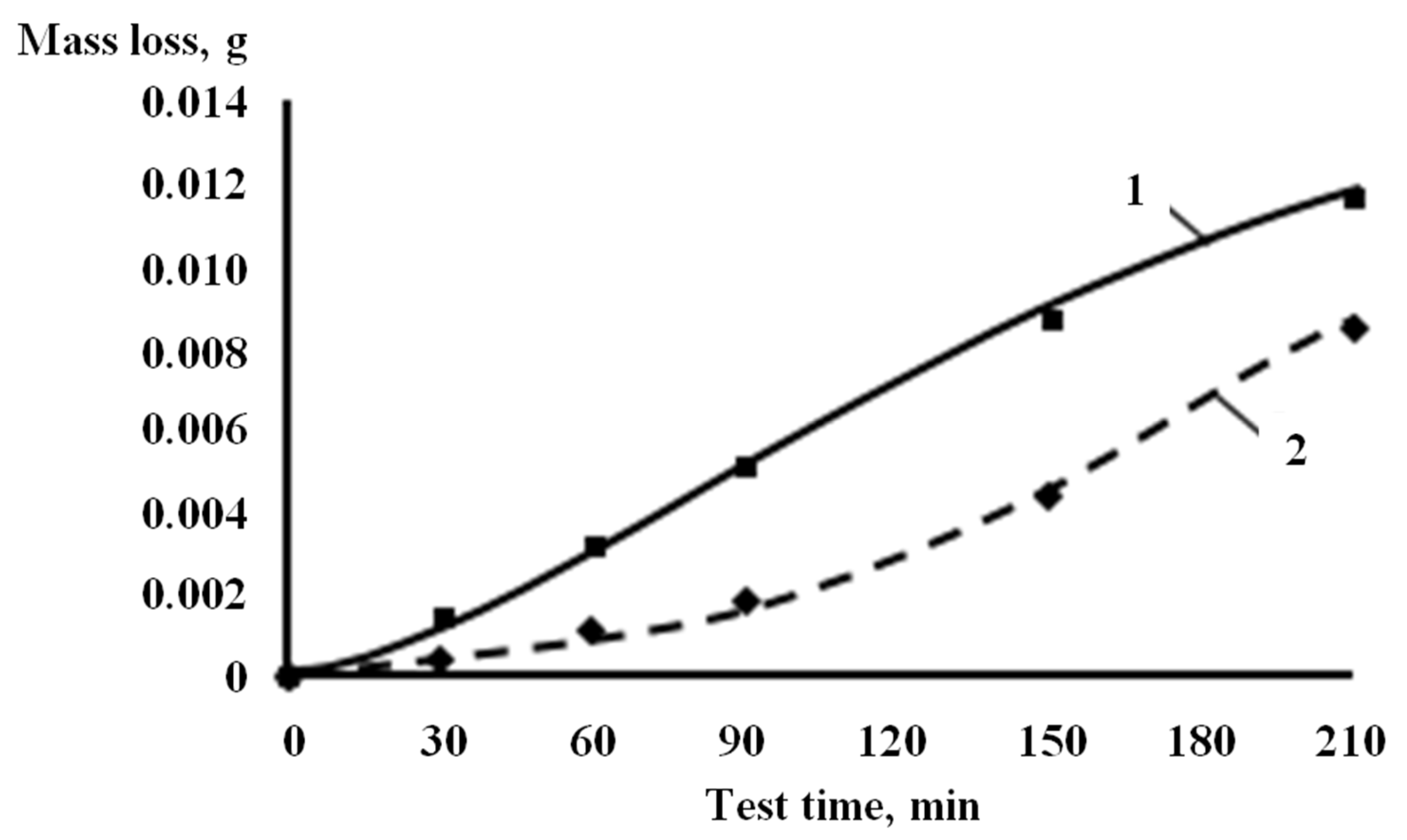
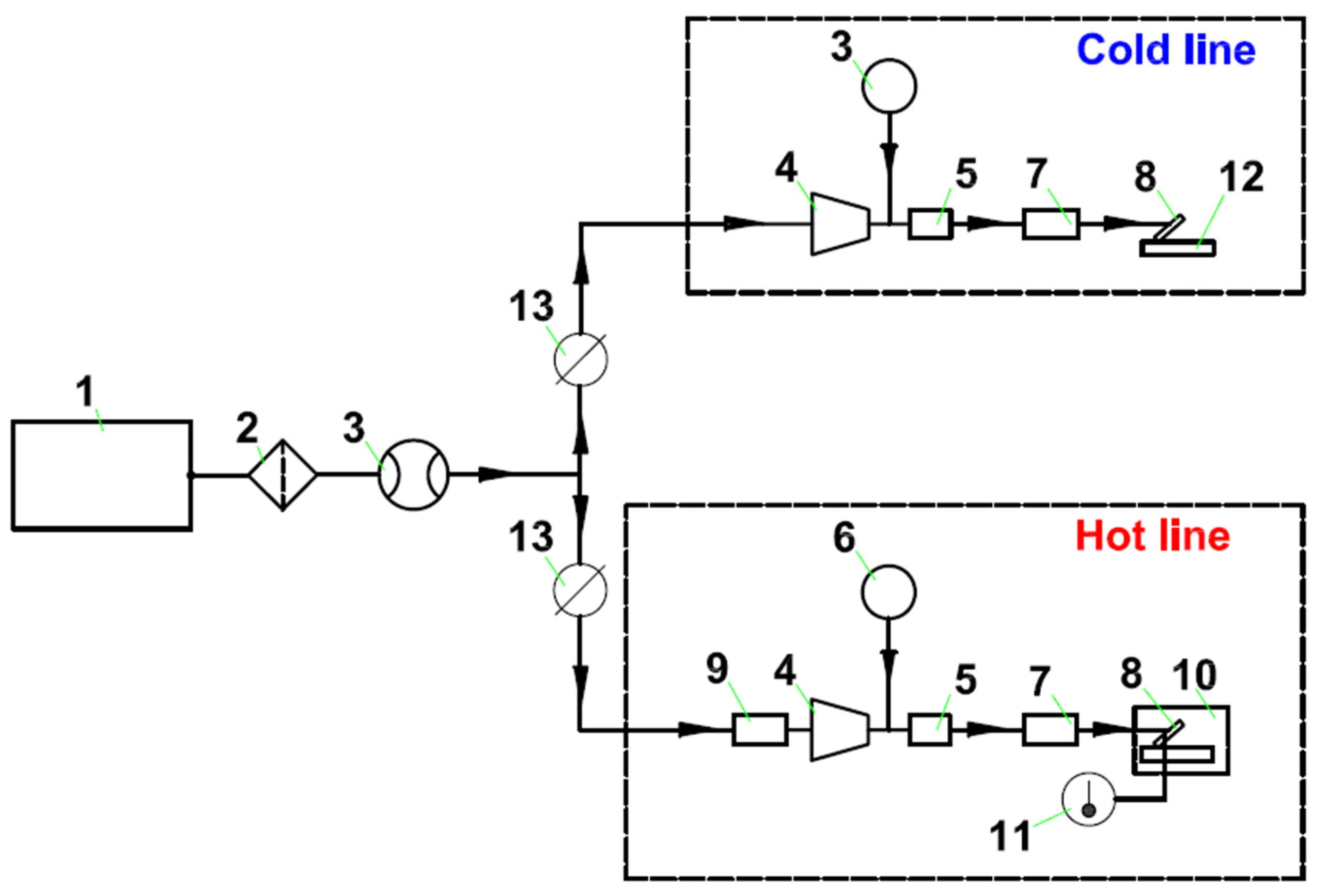

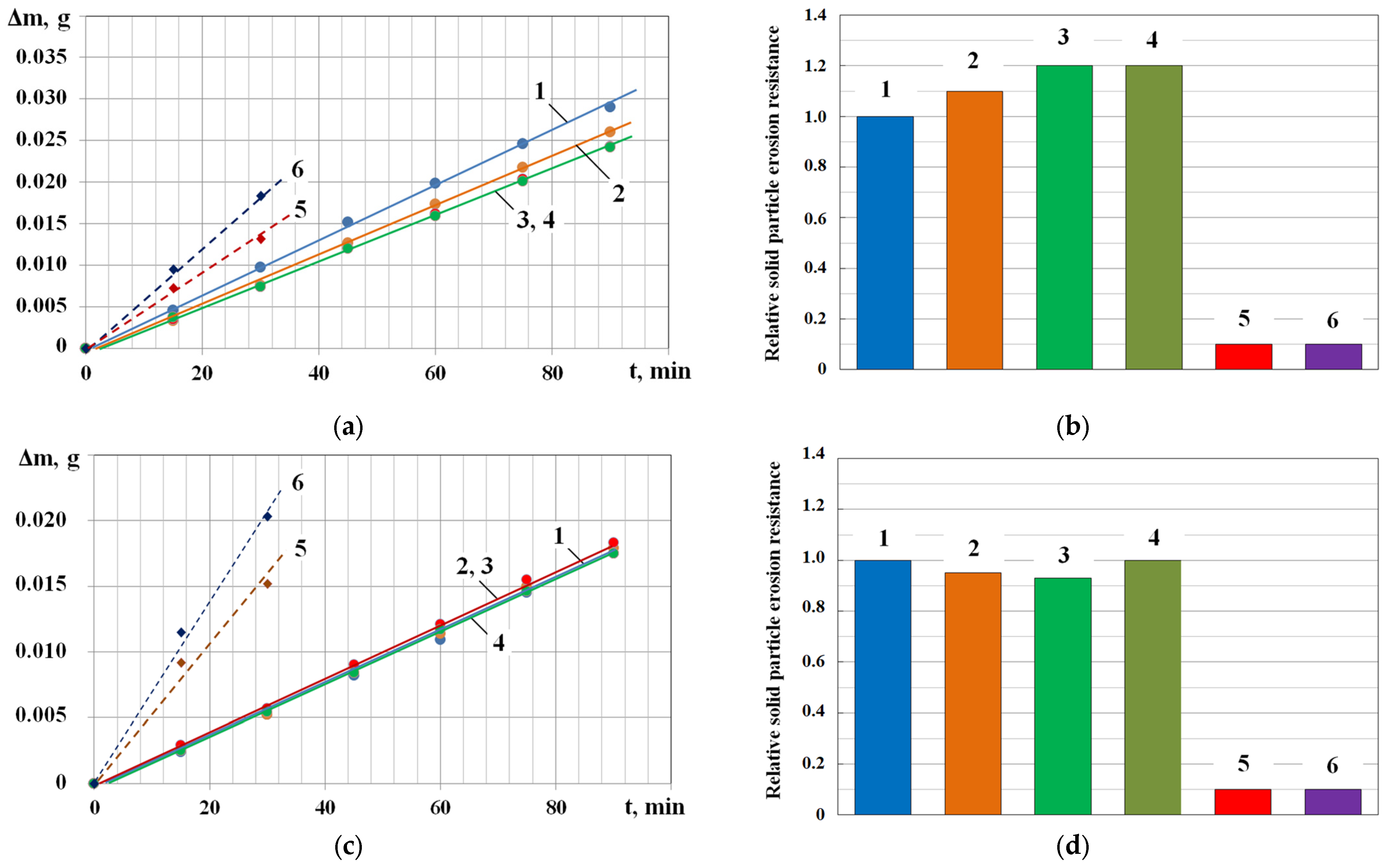
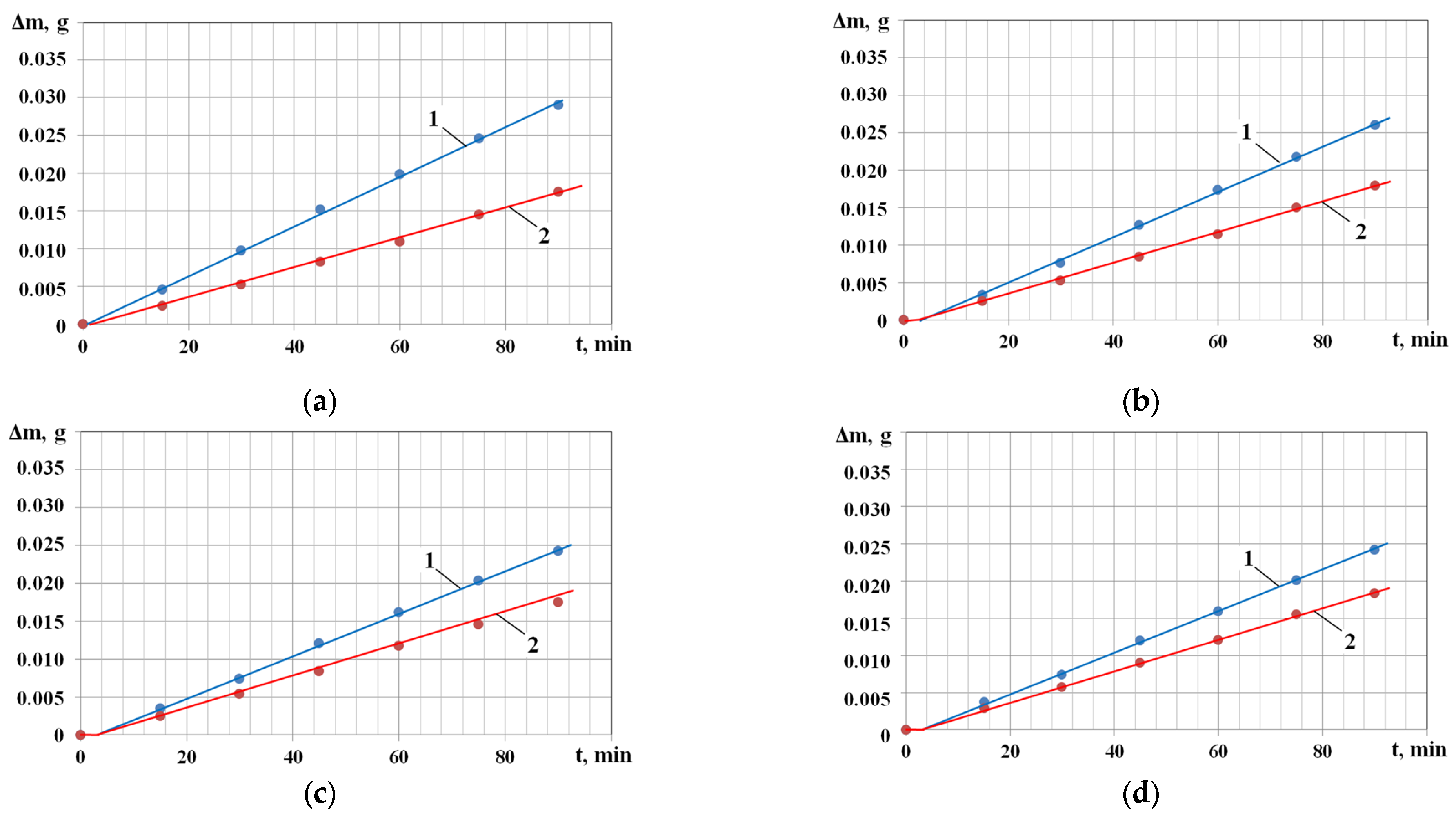
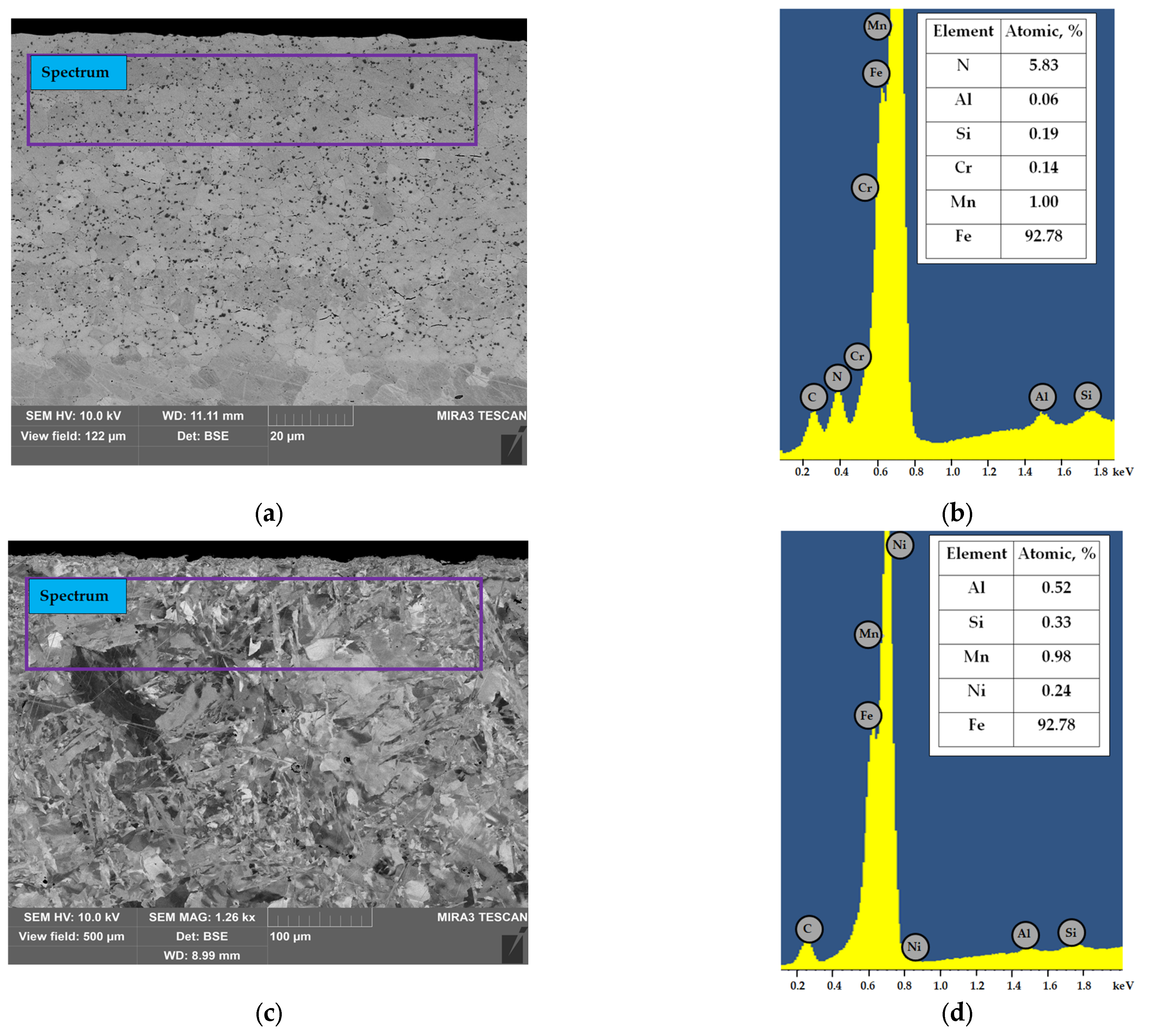
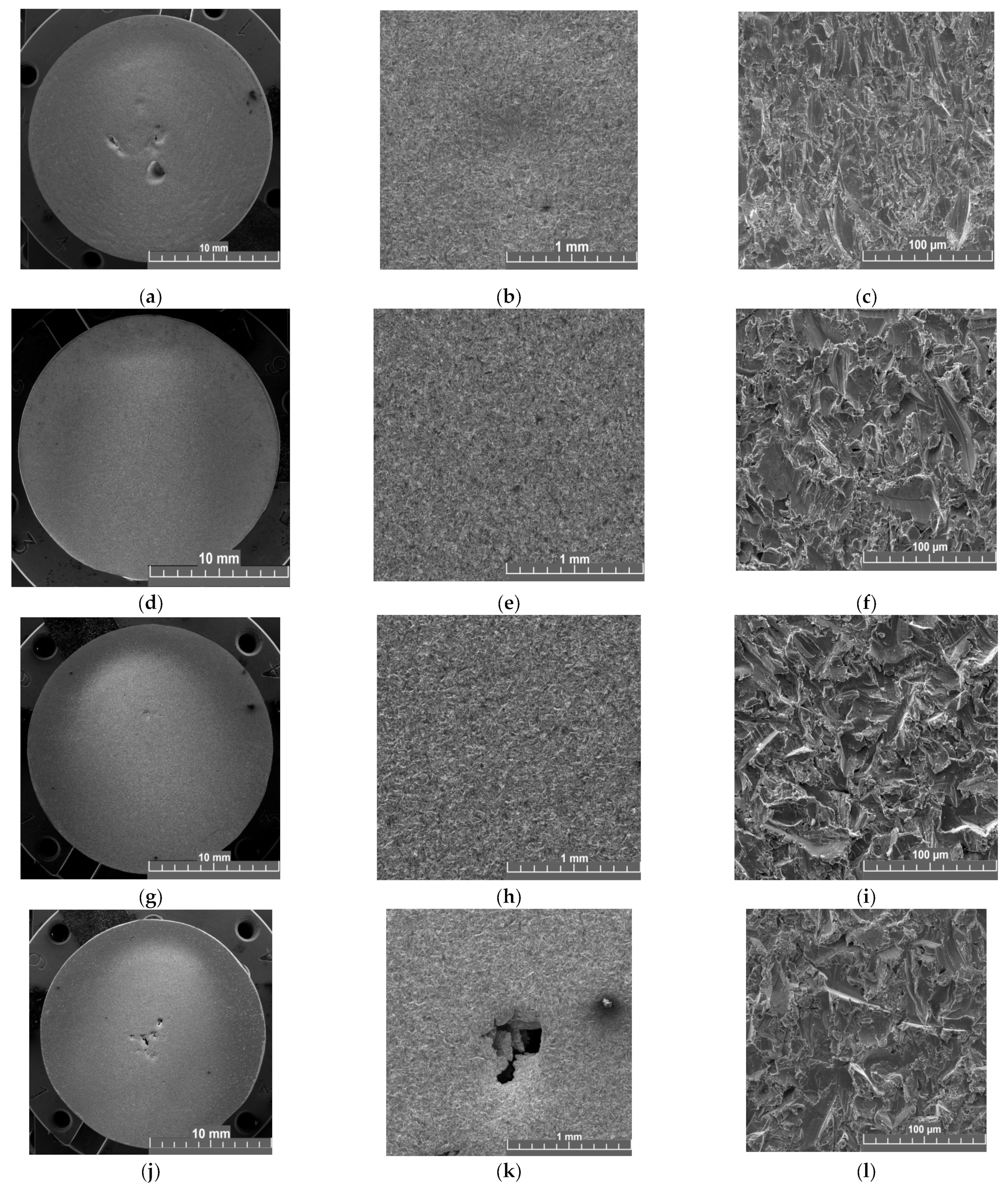
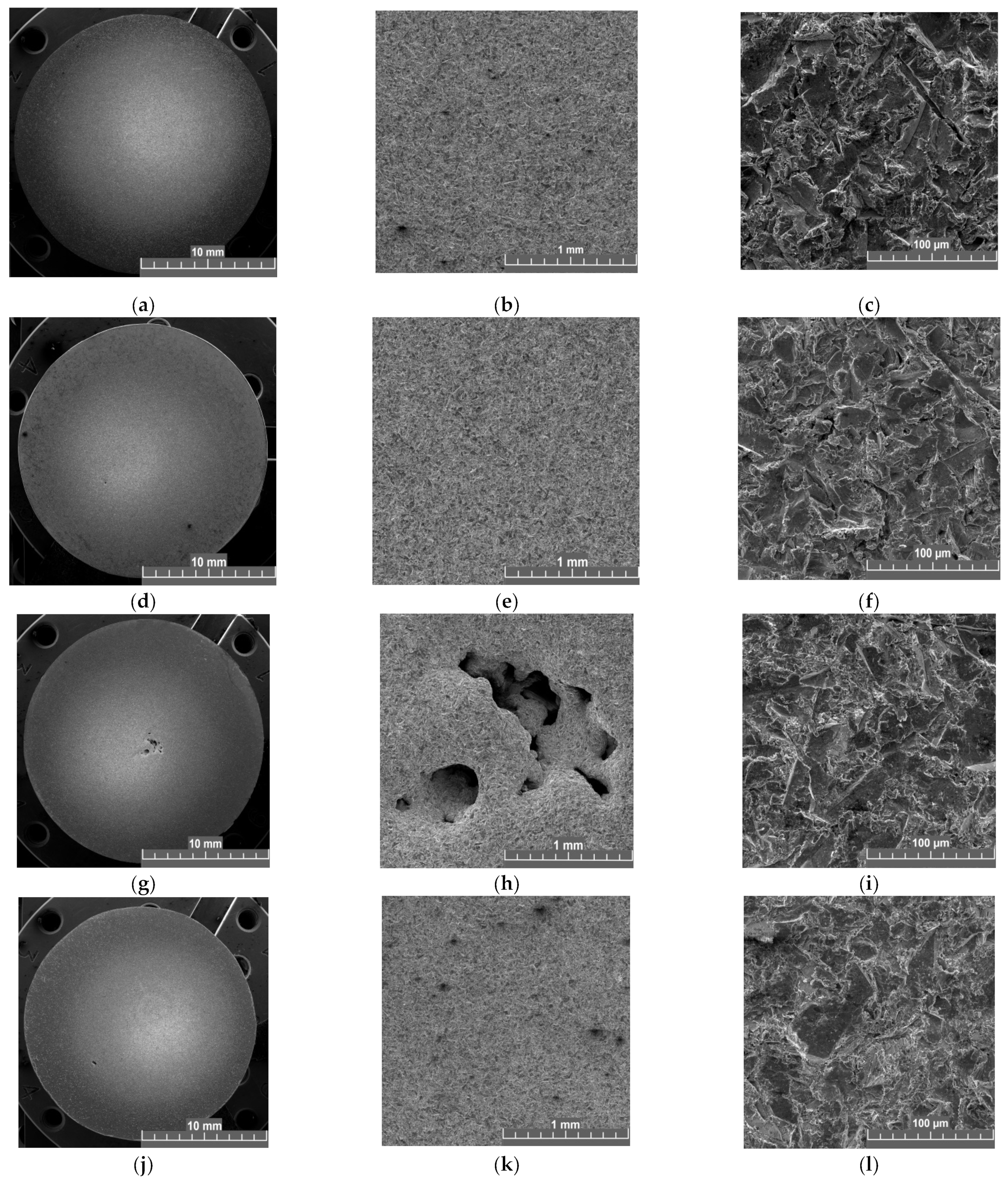
| C, % wt. | Si, % wt. | Mn, % wt. | S, % wt. | P, % wt. | Fe, % wt. |
|---|---|---|---|---|---|
| 0.27–0.35 | 0.20–0.52 | 0.4–0.6 | <0.045 | <0.04 | other |
| Parameter | Value |
|---|---|
| Particle size of Al2O3 (electrocorundum) | 250–300 μm |
| Air-abrasive flow rate | 170 m/s |
| Particulate matter flow rate | 5 × 10−5 kg per second |
| Air-abrasive flow impact angle | 30°, 90° |
| Specimen surface temperature | 25 °C |
| Number of samples engaged in experiment | 1 |
| Total test time | 90 min |
| Material | Modification | Type of Modification | Duration of Modification, h | HV0.01 | Depth of Modified Layer, μm |
|---|---|---|---|---|---|
| 30 L | Nitriding | I | 2.5 | 333 ± 18 | 35 ± 5 |
| II | 5 | 438 ± 18 | 65 ± 5 | ||
| III | 10 | 480 ± 30 | 80 ± 5 | ||
| Boriding | I | 3 | 2010 ± 60 | 80 ± 5 | |
| II | 6 | 2180 ± 40 | 150 ± 5 |
Disclaimer/Publisher’s Note: The statements, opinions and data contained in all publications are solely those of the individual author(s) and contributor(s) and not of MDPI and/or the editor(s). MDPI and/or the editor(s) disclaim responsibility for any injury to people or property resulting from any ideas, methods, instructions or products referred to in the content. |
© 2023 by the authors. Licensee MDPI, Basel, Switzerland. This article is an open access article distributed under the terms and conditions of the Creative Commons Attribution (CC BY) license (https://creativecommons.org/licenses/by/4.0/).
Share and Cite
Tkhabisimov, A.; Mednikov, A.; Zilova, O. Studies of the Solid Particle Erosion Resistance of 30 L Steel with Different Types of Surface Modification. Metals 2023, 13, 1978. https://doi.org/10.3390/met13121978
Tkhabisimov A, Mednikov A, Zilova O. Studies of the Solid Particle Erosion Resistance of 30 L Steel with Different Types of Surface Modification. Metals. 2023; 13(12):1978. https://doi.org/10.3390/met13121978
Chicago/Turabian StyleTkhabisimov, Alexander, Alexey Mednikov, and Olga Zilova. 2023. "Studies of the Solid Particle Erosion Resistance of 30 L Steel with Different Types of Surface Modification" Metals 13, no. 12: 1978. https://doi.org/10.3390/met13121978





